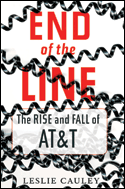End of the Line: The Rise and Fall of AT&T
By Leslie Cauley
Free Press, August 2005
320 pages, $26
Every generation or so we relearn this lesson: Technology isn’t a strategy.
It doesn’t matter if we are discussing mainframes in the 1960s, personal computers in the 1980s or the Internet in the year 2000. A new advancement comes along, and all of a sudden executives start talking about how their “proprietary technology” all but insulates them from traditional business worries. If this account of the decline of AT&T Corp. does nothing else, it may get this message through to some managers: Technology isn’t a strategy.
The reason that AT&T is about to be bought by SBC Communications—which, of course, used to be an AT&T subsidiary back in the days when SBC was known as Southwestern Bell, and Ma Bell had a monopoly on phone service—has absolutely nothing to do with the quality of AT&T’s technology, or with the research produced by Bell Labs. The technology was fine. The research was fine. Management was the problem, as USA Today reporter Cauley makes clear in this detailed account.
After the telephone market was deregulated in 1983, and the AT&T monopoly was dismantled, former CEO Robert Allen had almost a full decade to figure out what AT&T should look like. Yet he never was able to pull the trigger on a new strategy.
At various points, the company had the opportunity to become the dominant player in both the mobile phone market—what would have been more natural than using your (state-of-the-art) AT&T wireless phone to connect to the (state-of-the-art) AT&T wireless network—and the Internet. But management passed on both opportunities, thinking that the markets would not be large enough. And by the time they realized the markets were large enough, the company was either too far behind established competitors or executed badly in their attempt to catch up, or both.
Brought in to save the company, Michael Armstrong came up with a strategy: AT&T would be the one-stop supplier for customers looking for communication and entertainment. Yet he, too, failed to execute. The company never gained critical mass to put the plan into effect nationwide, and by overpaying in one cable deal after another, he pushed the company dangerously close to bankruptcy.
Cauley chronicles all this in great detail. The reporting is often vivid, but the details fail to hang together in a narrative thread, and the impression you get is of a series of snapshots. Cauley often puts together a string of events without explaining exactly when they occurred, which tends to blur the chronology, so you sometimes don’t know the exact time period she is discussing.
As annoying as that is, it’s secondary. There is no doubt that she gets the conclusion right: “AT&T will one day be studied not for its contributions to the world, which are substantial, but rather as a textbook example of how not to manage a business empire.” Technology is not a strategy.
Paul B. Brown is the author of numerous business books, including The Rules, which will be published by Doubleday this fall.
